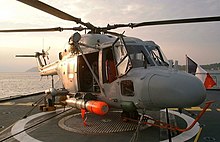Mark 46 torpedo
Appearance
| Mark 46 torpedo | |
|---|---|
 A Mk 46 exercise torpedo launched from USS Mustin. | |
| Type | Lightweight antisubmarine torpedo[1] |
| Place of origin | United States |
| Service history | |
| In service | • Mod 0: 1963[1] • Mod 5: 1979 |
| Used by | See operators |
| Production history | |
| Designer | Naval Ordnance Test Station Pasadena[1] Aerojet[1] Alliant Techsystems |
| Designed | 1960[1] |
| Manufacturer | Aerojet[1] Naval Ordnance Station Forest Park Honeywell Raytheon[2] |
| Variants | Mod 0[1] Mod 1 Mod 2 Mod 5 Mod 5A Mod 5A(S) Mod 5A(SW)[2] |
| Specifications | |
| Mass | 508 lb (230.4 kg) |
| Length | 8 ft 6 in (2.6 m) |
| Diameter | 12.75 in (323.8 mm) |
| Warhead | PBXN-103 high explosive (bulk charge) |
| Warhead weight | 96.8 lb (43.9 kg) |
| Engine | Two-speed, reciprocating external combustion |
| Propellant | Otto fuel II |
Operational range | 12,000 yd (10,972.8 m) |
| Maximum depth | >1,200 ft (365.8 m) |
| Maximum speed | >40 kn (74.1 km/h; 46.0 mph) |
Guidance system | Active or passive/active Acoustic homing |
Launch platform | Mark 32 Surface Vessel Torpedo Tubes, ASW Aircraft, RUM-139 VL-ASROC |


The Mark 46 torpedo is the backbone of the United States Navy's lightweight anti-submarine warfare torpedo inventory, and is the current NATO standard. These aerial torpedoes are designed to attack high-performance submarines, and current variants, such as the Mark 46 Mod 5, are expected to remain in service until the year 2015. In 1989, a major upgrade program for the Mod 5 began to improve its shallow-water performance, resulting in the Mod 5A and Mod 5A(S).
Design details
- Mark 46, Mod 5
- Primary Function: Air and ship-launched lightweight torpedo[3]
- Contractor: Alliant Techsystems
- Power Plant: Two-speed, reciprocating external combustion; Mono-propellant (Otto fuel II)
- Length: 8 ft 6 in (2.59 m) tube launch configuration (from ship),[4] 14 ft 9 in (4.5 m) with ASROC rocket booster[3]
- Weight: 508 lb (231 kg)[3] (warshot configuration)
- Diameter: 12.75 in (324 mm)[4]
- Range: 12,000 yd (11 km)[3]
- Depth: > 1,200 ft (365 m)
- Speed: > 40 knots (46 mph, 74 km/h)[3]
- Guidance System: Homing mode: Active or passive/active acoustic homing[4]
- Launch/search mode: Snake or circle search
- Warhead: 96.8 lb (44 kg)[3] of PBXN-103 high explosive (bulk charge)
- Date Deployed: 1967 (Mod 0);[3] 1979 (Mod 5)
Yu-7 variant
The Chinese Yu-7 torpedo is said to be based on the Mk 46 Mod 2.[5] Currently, the Chinese Navy use the Yu-7 ASW torpedo, deployed primarily on ships and ASW helicopters.[6]
Operators

 Australia
Australia Bahrain
Bahrain Belgium
Belgium Brazil
Brazil Canada
Canada Chile
Chile Ecuador
Ecuador Egypt
Egypt France
France Germany
Germany Greece
Greece Indonesia
Indonesia Iran
Iran Israel
Israel Italy
Italy Japan
Japan Kuwait
Kuwait Mexico
Mexico Morocco
Morocco Netherlands
Netherlands New Zealand
New Zealand Norway
Norway Pakistan
Pakistan Peru
Peru Portugal
Portugal Saudi Arabia
Saudi Arabia South Korea
South Korea Spain
Spain Taiwan
Taiwan Thailand
Thailand Turkey
Turkey United Arab Emirates
United Arab Emirates United Kingdom
United Kingdom United States[7]
United States[7]
See also
- CAPTOR mine (a sea mine which incorporates a Mk 46 torpedo)
- MU90 Impact torpedo
- Mark 50 torpedo
- Mark 54 MAKO Lightweight Torpedo
- Stingray torpedo
References
- Citations
- ^ a b c d e f g Jolie, E.W. (15 September 1978). "A Brief History of US Navy Torpedo Development: Torpedo Mk46". Retrieved 24 June 2013.
- ^ a b c d e f g Thomas, Vincent C. The Almanac of Seapower 1987 Navy League of the United States (1987) ISBN 0-9610724-8-2 pp.190-191
- ^ a b c Polmar, Norman "The Ships and Aircraft of the U.S. Fleet: Torpedoes" United States Naval Institute Proceedings November 1978 p.160
- ^ Chinese Defence Today, “YU-7 Anti-Submarine Torpedo”
- ^ (Chinese language)
- ^ Weapon - Mk. 46 torpedo
